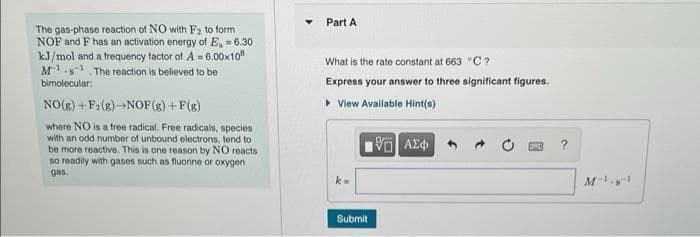Part A The gas-phase reaction of NO with F2 to form NOF and F has an activation energy of E, - 6.30 kJ/mol and a frequency factor of A = 6.00x10 M . The reaction is believed to be What is the rate constant at 663 "C? binolecular: Express your answer to three significant figures. • View Available Hint() NO(8) + F. (8)NOF (g) + F(g) where NO is a tree radical. Free radicals, species with an odd number of unbound electrons, tend to be more reactive. This is one reason by NO reacts so readily with gases such as fluorine or oxygen gas. M- Submit
Part A The gas-phase reaction of NO with F2 to form NOF and F has an activation energy of E, - 6.30 kJ/mol and a frequency factor of A = 6.00x10 M . The reaction is believed to be What is the rate constant at 663 "C? binolecular: Express your answer to three significant figures. • View Available Hint() NO(8) + F. (8)NOF (g) + F(g) where NO is a tree radical. Free radicals, species with an odd number of unbound electrons, tend to be more reactive. This is one reason by NO reacts so readily with gases such as fluorine or oxygen gas. M- Submit
Chemistry: An Atoms First Approach
2nd Edition
ISBN:9781305079243
Author:Steven S. Zumdahl, Susan A. Zumdahl
Publisher:Steven S. Zumdahl, Susan A. Zumdahl
Chapter11: Chemical Kinetics
Section: Chapter Questions
Problem 75E: One mechanism for the destruction of ozone in the upper atmosphere is a. Which species is a...
Related questions
Question

Transcribed Image Text:Part A
The gas-phase reaction of NO with F2 to form
NOF and F has an activation energy of E, = 6.30
kJ/mol and a frequency factor of A = 6.00x10
M1.s. The reaction is believed to be
What is the rate constant at 663 °C ?
binolecular:
Express your answer to three significant figures.
NO(8) + F2 (8)NOF(g) +F(g)
• View Available Hint(a)
where NO is a free radical. Free radicals, species
with an odd number of unbound olectrons, tend to
be more reactive. This is one reason by NO reacts
so readily with gases such as fluorine or oxygen
gas.
Submit
Expert Solution
This question has been solved!
Explore an expertly crafted, step-by-step solution for a thorough understanding of key concepts.
Step by step
Solved in 4 steps

Knowledge Booster
Learn more about
Need a deep-dive on the concept behind this application? Look no further. Learn more about this topic, chemistry and related others by exploring similar questions and additional content below.Recommended textbooks for you

Chemistry: An Atoms First Approach
Chemistry
ISBN:
9781305079243
Author:
Steven S. Zumdahl, Susan A. Zumdahl
Publisher:
Cengage Learning


Chemistry
Chemistry
ISBN:
9781305957404
Author:
Steven S. Zumdahl, Susan A. Zumdahl, Donald J. DeCoste
Publisher:
Cengage Learning

Chemistry: An Atoms First Approach
Chemistry
ISBN:
9781305079243
Author:
Steven S. Zumdahl, Susan A. Zumdahl
Publisher:
Cengage Learning


Chemistry
Chemistry
ISBN:
9781305957404
Author:
Steven S. Zumdahl, Susan A. Zumdahl, Donald J. DeCoste
Publisher:
Cengage Learning

Chemistry: Principles and Reactions
Chemistry
ISBN:
9781305079373
Author:
William L. Masterton, Cecile N. Hurley
Publisher:
Cengage Learning

Chemistry by OpenStax (2015-05-04)
Chemistry
ISBN:
9781938168390
Author:
Klaus Theopold, Richard H Langley, Paul Flowers, William R. Robinson, Mark Blaser
Publisher:
OpenStax

Chemistry & Chemical Reactivity
Chemistry
ISBN:
9781337399074
Author:
John C. Kotz, Paul M. Treichel, John Townsend, David Treichel
Publisher:
Cengage Learning